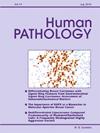Hyalinizing trabecular tumor of the thyroid: Interest of GLIS3 immunohistochemical study to detect PAX8::GLIS3 rearrangement
IF 2.7
2区 医学
Q2 PATHOLOGY
引用次数: 0
Abstract
Background
& Objective: Hyalinizing trabecular tumor of the thyroid (HTT) is a rare, low-risk neoplasm that poses diagnostic challenges. Very recently, PAX8::GLIS3 rearrangements were found to characterize HTT. We aimed to explore HTT's genetic profile, focusing on PAX8::GLIS3 rearrangements and GLIS3 immunohistochemical staining.
Methods
We conducted a retrospective study involving 8 cases histologically diagnosed as HTT. RNA sequencing and immunohistochemical staining for GLIS3 were performed on all cases.
Results
The study included five females and three males, with a tumor size ranging from 3 to 45 mm. RNA sequencing analysis showed PAX8::GLIS3 rearrangement in 6 cases (86 %). No other molecular alterations were found. However, one case failed due to the tissue quality, and one case did not show any gene fusion. Immunohistochemical staining for GLIS3 revealed nuclear positive expression in tumor cells for all cases where gene fusion was detected (100 %). A control group of 20 HTT mimickers showed no immunostaining for GLIS 3.
Conclusion
Our study confirms the consistent presence of PAX8::GLIS3 rearrangement in hyalinizing trabecular tumor (HTT) of the thyroid. Additionally, our novel finding of GLIS3 expression via immunohistochemistry enhances diagnostic precision for these tumors. Notably, our series demonstrates the correlation between positive GLIS3 expression and detection of PAX8::GLIS3 fusion by RNA sequencing, potentially expediting HTT diagnosis.
甲状腺透明化小梁肿瘤:GLIS3免疫组化检测PAX8::GLIS3重排
背景与目的:甲状腺透明化小梁肿瘤(HTT)是一种罕见、低风险的肿瘤,其诊断具有挑战性。最近,PAX8::GLIS3重排被发现是HTT的特征。我们的目的是探索HTT的遗传谱,重点是PAX8::GLIS3重排和GLIS3免疫组织化学染色。方法:我们对8例组织学诊断为HTT的病例进行回顾性研究。所有病例均行GLIS3的RNA测序和免疫组化染色。结果:该研究包括5名女性和3名男性,肿瘤大小从3到45mm不等。RNA测序分析显示6例(86%)患者PAX8::GLIS3重排。没有发现其他分子变化。但1例因组织质量原因失败,1例未表现出任何基因融合。GLIS3的免疫组化染色在所有检测到基因融合的病例中显示肿瘤细胞核阳性表达(100%)。对照组20例HTT模拟物未见GLIS 3免疫染色。结论:我们的研究证实了PAX8::GLIS3重排在甲状腺透明化小梁瘤(HTT)中一致存在。此外,我们通过免疫组化检测GLIS3表达的新发现提高了这些肿瘤的诊断精度。值得注意的是,我们的系列研究表明,GLIS3阳性表达与RNA测序检测PAX8::GLIS3融合之间存在相关性,这可能加快HTT的诊断。
本文章由计算机程序翻译,如有差异,请以英文原文为准。
求助全文
约1分钟内获得全文
求助全文
来源期刊

Human pathology
医学-病理学
CiteScore
5.30
自引率
6.10%
发文量
206
审稿时长
21 days
期刊介绍:
Human Pathology is designed to bring information of clinicopathologic significance to human disease to the laboratory and clinical physician. It presents information drawn from morphologic and clinical laboratory studies with direct relevance to the understanding of human diseases. Papers published concern morphologic and clinicopathologic observations, reviews of diseases, analyses of problems in pathology, significant collections of case material and advances in concepts or techniques of value in the analysis and diagnosis of disease. Theoretical and experimental pathology and molecular biology pertinent to human disease are included. This critical journal is well illustrated with exceptional reproductions of photomicrographs and microscopic anatomy.
 求助内容:
求助内容: 应助结果提醒方式:
应助结果提醒方式:


